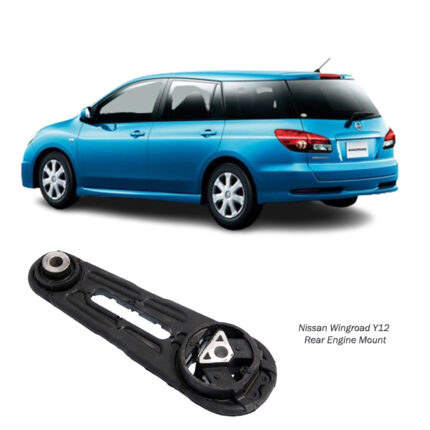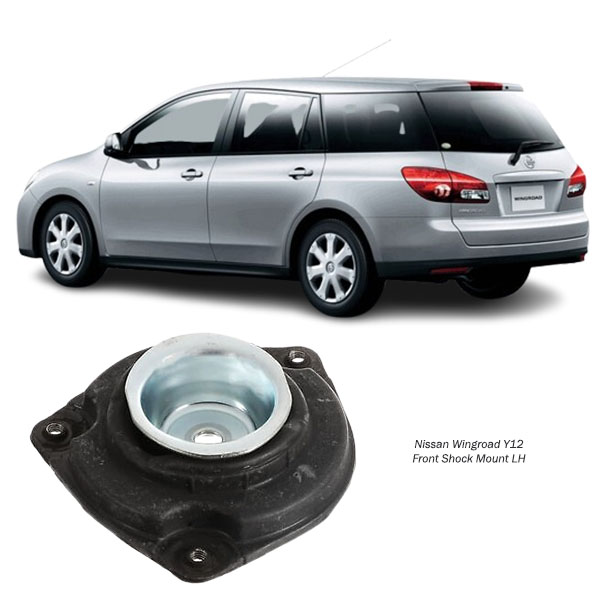-14%
Get Nissan Wingroad Y12 Front Shock Mount LH 54321-EW80A in Kenya
Your vehicle’s suspension system is a beautifully engineered network of springs, shocks, and linkages designed to absorb bumps and keep your car planted on the road. But even the best suspension parts need a solid foundation—and that’s exactly what the Front Shock Mount (LH) provides. It may not get as much attention as shock absorbers or coil springs, but this critical component holds everything in place and plays a key role in your car’s comfort, handling, and safety. 🧩🔧
Let’s dive into the world of the Left-Hand Front Shock Mount, what it does, why it matters, and how to spot when it’s time for a replacement.
🧭 What is a Front Shock Mount (LH)?
The Front Shock Mount LH—or Left-Hand Front Shock Absorber Mount—is the upper mounting point where the left front shock absorber or strut assembly connects to the vehicle’s chassis. It’s essentially the bridge between the suspension and the body of the car. 🌉
While it may seem like just a bracket or joint, it plays multiple roles:
-
Secures the shock absorber to the frame
-
Absorbs and dampens road vibrations
-
Allows for rotational movement during steering (in strut assemblies)
-
Reduces noise and harshness inside the cabin
In vehicles with MacPherson strut suspension, the shock mount also contains a bearing that allows the strut to rotate with the steering—making it even more critical for smooth, responsive handling. 🛞
⚙️ Anatomy of a Shock Mount
The front shock mount isn’t just a single block of metal or rubber. It’s a cleverly designed component that often includes:
-
Rubber or polyurethane insulators: Cushion and isolate road vibrations 🧽
-
Metal plates or brackets: Provide structural strength and support 🏗️
-
Bearing assembly (in strut mounts): Allows for rotation during steering 🔁
The LH (Left-Hand) designation means it’s installed on the driver’s side in most vehicles. Each side has a unique orientation and must be replaced with the correct match.
🧠 Why It’s So Important
Though small, the front shock mount does a lot of heavy lifting—literally and figuratively. Here’s why it’s so vital:
✅ 1. Structural Support
The mount holds the shock or strut assembly firmly in place. Without it, the shock has nowhere to anchor, and your suspension can’t function. 🧱
✅ 2. Vibration Damping
The rubber insulator absorbs the constant micro-movements caused by driving, reducing the vibration transferred into the vehicle cabin. 🚙💤
✅ 3. Steering Performance
In strut-based systems, the mount includes a bearing that allows the entire strut to rotate when you turn the steering wheel. A bad mount = stiff, noisy, or delayed steering. 🔄🛞
✅ 4. Ride Comfort
A healthy mount reduces jolts and bumps, making your ride smoother and quieter. 🚗💨
🚨 Signs of a Worn or Failing Front Shock Mount (LH)
Like any suspension component, shock mounts wear out over time—especially due to road salt, heat, moisture, and the constant pounding of everyday driving. Here are some telltale signs it’s time for a new one:
🔊 1. Clunking or Knocking Noises
You may hear noises when going over bumps, turning the wheel, or during hard braking. That’s the sound of metal components moving more than they should.
📐 2. Poor Steering Response
Worn mounts can make the steering feel loose or unresponsive. In vehicles with strut mounts, you might also hear creaking when turning the wheel.
🚧 3. Uneven Tire Wear
If the mount no longer keeps the shock in proper alignment, your tires may show abnormal wear patterns.
🌀 4. Excessive Vibration
You may feel more vibration through the steering wheel or floorboards, especially on rough roads.
👀 5. Visible Damage
Cracks, torn rubber, corrosion, or sagging in the mount are clear signs it’s time to replace it.
🔧 What Happens During Replacement?
Replacing the Front Shock Mount LH is a job best handled by a professional, as it involves working with high-tension suspension components. Here’s what’s typically involved:
1. Raise the Vehicle Safely 🛞
The front left wheel is removed to access the strut or shock assembly.
2. Remove the Shock or Strut Assembly 🔩
The component is unbolted from the vehicle and taken out for disassembly.
3. Compress the Coil Spring (if applicable) 🔧
This is a delicate step, as the spring is under high pressure. Compressing it safely allows access to the mount.
4. Replace the Shock Mount ✨
The old mount is removed and replaced with a new one, ensuring correct alignment and orientation.
5. Reassemble and Reinstall 🔁
The strut or shock is reassembled with the new mount and bolted back into place.
6. Alignment Check 🎯
An alignment is often recommended afterward to ensure proper suspension geometry.
🔄 OEM vs Aftermarket Mounts
When replacing your LH front shock mount, you’ll encounter two main options:
🔹 OEM (Original Equipment Manufacturer)
-
Built to exact factory specs
-
Excellent fit and performance
-
Great for everyday driving
🔸 Aftermarket
-
May offer higher performance (stiffer materials, better bearings)
-
Wider range of pricing
-
Some are designed for lifted or lowered vehicles
If comfort and reliability are your top priorities, OEM is a safe bet. For enhanced performance or off-road use, consider high-quality aftermarket options. ⚙️💡
🧰 Maintenance Tips to Extend Shock Mount Life
While shock mounts don’t require routine maintenance, a few habits can extend their lifespan:
-
Avoid potholes and rough terrain when possible 🕳️
-
Inspect suspension components during routine service 🔍
-
Replace shocks/struts and mounts together for best results 🤝
-
Listen for noises and respond early to symptoms 👂
🧩 The Final Word: A Small Part With a Major Job
The Front Shock Mount LH might not be flashy or complex, but it’s an essential part of your suspension’s backbone. It anchors your shock absorber, absorbs vibration, enables steering movement, and helps deliver the comfortable, controlled ride you expect from your vehicle. 💪🌉
Driving with a worn or damaged shock mount doesn’t just impact comfort—it can compromise steering, wear down tires prematurely, and even affect braking distance. That’s why keeping this little part in top shape is a big deal for safety and performance.
Follow us on Facebook for more parts.






Reviews
Clear filtersThere are no reviews yet.